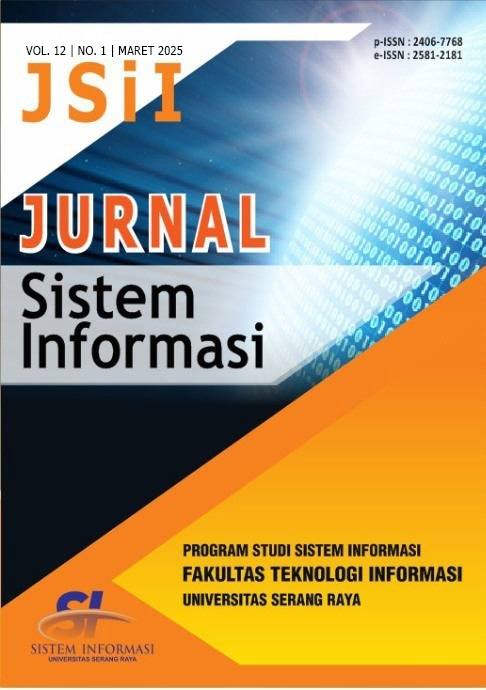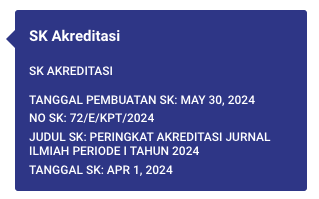PRESERVING THE INDIGENOUS MUSICAL INSTRUMENTS OF PAPUAN USING AUGMENTED REALITY TECHNOLOGY
DOI:
https://doi.org/10.30656/jsii.v12i1.9947Abstract
This study explores the use of augmented reality (AR) technology as a technology enabling the preservation of traditional Papua musical instruments. It aims of understanding factors that influence the adoption of this technology by people living in Papua who are not indigenous Papuans. The use of AR as a tool for cultural preservation is still limited, particularly in the context of Papua, highlighting a research gap concerning the acceptance of AR technology in regions rich in culture but limited in technology adoption. The study employs Design Science Research (DSR) as a research framework. The development and evaluation in the DSR are conducted rigorously and robustly. Once the AR artifact is developed using uniteAR tool, subsequently it is evaluated employing UTAU2 as a theoretical lens. Particularly in the evaluation stage, it involves 115 respondents as participants in data collection. The data is analyzed with partial least square structural equation modeling (PLS-SEM). The main findings indicate that the measurement model has good reliability and validity, with an R² value of 0.8, meaning that Behavioral Intention and Use Behavior explain 80% of the variability in AR technology adoption. The findings also reveal that performance expectancy, effort expectancy, and facilitating conditions are significant factors driving AR technology adoption among respondents. The implications of this study are highly relevant for the development of strategies using AR technology to introduce and preserve traditional Papua musical instruments. These findings can be used by local governments, indigenous communities, and local content developers to design more effective solutions for enhancing AR adoption in Papua, taking into account key factors influencing public behavioral intentions. Thus, this research not only provides theoretical insights into technology adoption but also strengthens the integration of culture and technology in Papua, opening opportunities for more interactive and engaging cultural preservation.
Keywords: Technology Adoption, Augmented Reality, Papua Traditional Musical Instruments, PLS-SEM, UTAUT
References
[1] A. Solihin, D. I. Mulyana, and M. B. Yel. (2022), “Klasifikasi Jenis Alat Musik Tradisional Papua menggunakan Metode Transfer Learning dan Data Augmentasi,” J. SISKOM-KB (Sistem Komput. dan Kecerdasan Buatan), Vol. 5. No. 2. Available:https://doi.org/10.47970/siskom-kb.v5i2.279
[2] F. Siswadhi, C. Carolina, and S. Marselina, “Optimalisasi Peran Pemuda Dalam Pembangunan Ekonomi Kreatif Berbasis Sektor Pariwisata,” J. Ekon. Sakti, vol. 9, no. 1, 2020.
[3] N. H. Mahmud, D. I. Inan, and I. Yusuf. (2024), “Development and Evaluation of the Utilization of Augmented Reality to Enhance the Physics Teaching and Learning Process Using the Design Science Research Method,” Jurasik (Jurnal Ris. Sist. Inf. dan Tek. Inform., Vol. 9, No. 1. Available: http://dx.doi.org/10.30645/jurasik.v9i1.729
[4] A. F. Ramadhan, A. D. Putra, and A. Surahman. (2021), “Aplikasi Pengenalan Perangkat Keras Komputer Berbasis Android Menggunakan Augmented Reality,” Comput. Sci. Ind. Eng., vol. 9, no. 2. Available: https://doi.org/10.33884/comasiejournal.v9i2.7624
[5] A. Tohir, F. Handayani, R. Sulistiana, V. Wiliyanti, T. Arifianto, and L. Husnita, “Augmented Reality dalam Proses Pemahaman Pembelajaran,” J. Rev. Pendidik. dan Pengajaran, vol. 7, no. 3, p. 8, 2024.
[6] M. Mahfudz. (2019), “Aplikasi Augmented Reality Pengenalan Alat Musik Gamelan Berbasis Android,” Dr. Diss. Univ. Technol. Yogyakarta.. Available: https://eprints.uty.ac.id/4371/1/Naskah%20Publikasi_Mahfudz_5140411113.pdf
[7] Ahmad Samed Al-Adwan, Rana Muhammad Sohail Jafar, Dan-Andrei Sitar-Tăut. (2024), “Breaking into the black box of consumers’ perceptions on metaverse commerce: An integrated model of UTAUT 2 and dual-factor theory”, Asia Pacific Management Review, Vol. 29, Issue 4. Available: https://doi.org/10.1016/j.apmrv.2024.09.004.
[8] María Luisa Villanueva Orbaiz, Marta Arce-Urriza. (2024). “The role of active and passive resistance in new technology adoption by final consumers: The case of 3D printing,” Technology in Society, Vol. 77. Available: https://doi.org/10.1016/j.techsoc.2024.102500.
[9] Agmasie Damtew Walle, Adamu Takele Jemere, Binyam Tilahun, Berhanu Fikadie Endehabtu, Sisay Maru Wubante, Mequannent Sharew Melaku, Masresha Derese Tegegne, Kassahun Dessie Gashu (2023). “Intention to use wearable health devices and its predictors among diabetes mellitus patients in Amhara region referral hospitals, Ethiopia: Using modified UTAUT-2 model, ”Informatics in Medicine Unlocked, Vol. 36. Available: https://doi.org/10.1016/j.imu.2022.101157.
[10] Mohd Hanafi Azman Ong, Muhammad Yassar Yusri, Nur Syafikah Ibrahim. (2023), “Use and behavioural intention using digital payment systems among rural residents: Extending the UTAUT-2 model,” Technology in Society, Vol. 74. Available: https://doi.org/10.1016/j.techsoc.2023.102305.
[11] P. Utomo, F. Kurniasari, and P. Purnamaningsih. (2021), “The Effects of Performance Expectancy, Effort Expectancy, Facilitating Condition, and Habit on Behavior Intention in Using Mobile Healthcare Application,” International Journal of Community Service & Engagement., Vol. 2, no. 4. Available: doi: 10.47747/ijcse.v2i4.529.
[12] H. Anjani, D. I. Inan, R. Juita, M. Sanglise, I. Engineering, and U. Papua, “Towards spatial information system adoption using extended tam and its success model,” vol. X, no. 4, 2024.
[13] J. H. Kandami, D. I. Inan, R. Juita, L. Y. Baisa, M. Sanglise, and M. Indra, “Development and Evaluation of Android-based Infrastructure Rental Application: A Design Science Research Approach,” J. Teknol. dan Manaj. Inform., vol. 10, no. 1, pp. 36–47, 2024.
[14] A. D. Oktavia, D. I. Inan, R. N. Wurarah, and O. A. Fenetiruma. (2024). “Analisis Faktor-faktor Penentu Adopsi E-Wallet di Papua Barat: Extended UTAUT 2 dan Perceived Risk,” Indonesian Journal of Machine Learning and Computer Science, Vol. 4, no. 2. Available: https://doi.org/10.57152/malcom.v4i2.1277
[15] P. Kašparová. (2023), “Intention to use business intelligence tools in decision making processes: applying a UTAUT 2 model,” Cent. Eur. J. Oper. Res., vol. 31, no. 3. Available: doi: 10.1007/s10100-022-00827-z.
[16] H. J. Jung, Y. J. Choi, and K. W. Oh. (2020). “Influencing factors of chinese consumers’ purchase intention to sustainable apparel products: Exploring consumer ‘attitude–behavioral intention’ gap,” Sustainability, Vol. 12, No. 5. Available: https://doi.org/10.3390/su12051770
[17] K. Tamilmani, N. P. Rana, N. Prakasam, and Y. K. Dwivedi. (2019), “The battle of Brain vs. Heart: A literature review and meta-analysis of ‘hedonic motivation’ use in UTAUT2,” International Journal of Information Management, Vol. 46. Available: https://doi.org/10.1016/j.ijinfomgt.2019.01.008
[18] F. Faul, E. Erdfelder, A.-G. Lang, and A. Buchner, “G*Power 3: A flexible statistical power analysis program for the social, behavioral, and biomedical sciences,” J. Mater. Environ. Sci., vol. 39, no. 2, pp. 175–191, 2007.
[19] D. Goodhue, W. Lewis, and R. Thompson. (2006), “PLS, small sample size, and statistical power in MIS research,” Proc. Annu. Hawaii Int. Conf. Syst. Sci., vol. 8. Available: doi: 10.1109/HICSS.2006.381.
[20] P. E. Setiawati, D. I. Inan, R. N. Wurahrah, R. Juita, and M. Sanglise, “How the Perceived Enjoyment Effect m-Payment Adoption in West Papua Province: DELONE and MCLEAN Information Systems Success Model,” JIPI (Jurnal Ilmu Penelitian dan Pembelajaran Inform., vol. 9, no. 3, pp. 1–23, 2024.
[21] J. Hair, W. Black, B. Babin, and R. Anderson, “Multivariate Data Analysis: A Global Perspective,” in Multivariate Data Analysis: A Global Perspective, vol. 7th, 2010.
[22] I. Ghozali, “Aplikasi Analisis Multivariate Dengan Program IBM SPSS 25 Edisi 9,” Badan Penerbit Universitas Diponegoro, 2018.
[23] J. Henseler, C. M. Ringle, and M. Sarstedt. (2015), “A new criterion for assessing discriminant validity in variance-based structural equation modeling,” J. Acad. Mark. Sci., Vol. 43, No. 1.Available: https://link.springer.com/article/10.1007/s11747-014-0403-8
[24] A. Saputra, D. I. Inan, R. Juita, M. Sanglise, and M. Indra, “Determinants of User Satisfaction with a Mobile Application Using the Extended Webqual 4 . 0 Method and Structural Equation Modelling : A Case of the PLN Mobile Application,” vol. 10, no. 1, pp. 39–48, 2024.
[25] J. F. Hair, Sarstedt, H. M., L., and V. G. Kuppelwieser. (2014), “Partial least squares structural equation modeling (PLS-SEM): An emerging tool in business research,” European Business Review, Vol. 26, No. 2, Available: https://doi.org/10.1108/EBR-10-2013-0128
[26] S. Maria, D. C. Darma, S. Amalia, Y. P. Hakim, and T. Pusriadi, “Readiness to face industry 4.0,” Int. J. Sci. Technol. Res., vol. 8, no. 9, pp. 2363–2368, 2019.
Downloads
Published
Issue
Section
License
Copyright (c) 2025 Noor Khosin, Dedi I Inan

This work is licensed under a Creative Commons Attribution-ShareAlike 4.0 International License.
- This work is licensed under a Creative Commons Attribution-ShareAlike 4.0 International License.
-
Author(s)' Warranties
The author warrants that the article is original, written by stated author(s), has not been published before, contains no unlawful statements, does not infringe the rights of others, is subject to copyright that is vested exclusively in the author and free of any third party rights, and that any necessary written permissions to quote from other sources have been obtained by the author(s).
- Information
- Notice about change in the copyright policy of the journal 'Jurnal Sistem Informasi (JSiI)' : "From Vol 1, onwards the copyright of the article published in the journal 'Jurnal Sistem Informasi' will be retained by the author"













.jpg)














